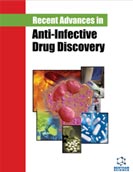
Abstract
Human Immunodeficiency Virus (HIV) infection continues to be a significant health burden in many countries around the world. Current HIV treatment through a combination of different antiretroviral drugs (cART) effectively suppresses viral replication, but drug resistance and crossresistance are significant challenges. This has prompted the search for novel targets and agents, such as nucleic acid aptamers. Nucleic acid aptamers are oligonucleotides that attach to the target sites with high affinity and specificity. This review provides a target-by-target account of research into anti-HIV aptamers and summarises the challenges and prospects of this therapeutic strategy, specifically in the unique context of HIV infection.
Graphical Abstract
[http://dx.doi.org/10.1089/apc.2009.0048] [PMID: 19803679]
[http://dx.doi.org/10.2147/HIV.S6882] [PMID: 22096389]
[http://dx.doi.org/10.1093/ofid/ofv138] [PMID: 26512359]
[http://dx.doi.org/10.1038/346818a0] [PMID: 1697402]
[http://dx.doi.org/10.7150/thno.25958] [PMID: 30128033]
[http://dx.doi.org/10.1007/BF03261896] [PMID: 23046156]
[http://dx.doi.org/10.1038/nrd.2016.199] [PMID: 27807347]
[http://dx.doi.org/10.1038/nrd1955] [PMID: 16518379]
[http://dx.doi.org/10.1161/CIRCULATIONAHA.107.724864] [PMID: 18025536]
[http://dx.doi.org/10.3390/s100504541] [PMID: 22399891]
[http://dx.doi.org/10.1007/s11095-004-7676-4] [PMID: 15648255]
[http://dx.doi.org/10.1093/nar/gkw725] [PMID: 27566147]
[http://dx.doi.org/10.3390/molecules24050941] [PMID: 30866536]
[http://dx.doi.org/10.1016/j.biotechadv.2015.02.008] [PMID: 25708387]
[http://dx.doi.org/10.1039/C5MB00045A] [PMID: 25720604]
[http://dx.doi.org/10.1016/S1074-5521(02)00136-9] [PMID: 12031665]
[http://dx.doi.org/10.1371/journal.pone.0082667] [PMID: 24376564]
[http://dx.doi.org/10.3390/molecules200711959] [PMID: 26133761]
[http://dx.doi.org/10.1016/S0968-0896(01)00028-1] [PMID: 11557339]
[http://dx.doi.org/10.1016/j.chembiol.2015.01.005] [PMID: 25754473]
[http://dx.doi.org/10.1016/j.biocel.2014.03.008] [PMID: 24661998]
[http://dx.doi.org/10.3390/ph6121507] [PMID: 24287493]
[http://dx.doi.org/10.1016/j.ijantimicag.2016.01.016] [PMID: 27032748]
[http://dx.doi.org/10.1016/j.ejmech.2012.07.045] [PMID: 22907035]
[http://dx.doi.org/10.1073/pnas.91.4.1356] [PMID: 7906414]
[http://dx.doi.org/10.1309/AJCP55KQYWSGZRKC] [PMID: 20855639]
[http://dx.doi.org/10.1021/bi0108599] [PMID: 11513587]
[http://dx.doi.org/10.1128/JVI.02626-09] [PMID: 20980522]
[http://dx.doi.org/10.1128/AAC.39.11.2426] [PMID: 8585721]
[http://dx.doi.org/10.1006/bbrc.2002.6521] [PMID: 11866454]
[http://dx.doi.org/10.1038/mtna.2015.1] [PMID: 25689224]
[http://dx.doi.org/10.1261/rna.7205405] [PMID: 15923374]
[http://dx.doi.org/10.1021/jm970658w] [PMID: 9733490]
[http://dx.doi.org/10.1016/S0968-0896(97)00161-2] [PMID: 9459021]
[http://dx.doi.org/10.1038/mt.2013.77] [PMID: 23629001]
[http://dx.doi.org/10.1172/JCI45876] [PMID: 21576818]
[http://dx.doi.org/10.1016/j.jmb.2008.10.071] [PMID: 19022262]
[http://dx.doi.org/10.1089/oli.2008.0103] [PMID: 18637731]
[http://dx.doi.org/10.1128/JVI.72.4.2846-2854.1998] [PMID: 9525604]
[http://dx.doi.org/10.3390/molecules200917511] [PMID: 26402662]
[http://dx.doi.org/10.1073/pnas.0406278102] [PMID: 15637158]
[http://dx.doi.org/10.2174/1568026043388547] [PMID: 15134551]
[http://dx.doi.org/10.1016/j.biochi.2005.03.013] [PMID: 16164998]
[http://dx.doi.org/10.1074/jbc.275.5.3421] [PMID: 10652335]
[http://dx.doi.org/10.1093/nar/21.4.831] [PMID: 8383840]
[http://dx.doi.org/10.4161/rna.7.6.14115] [PMID: 21160280]
[http://dx.doi.org/10.1016/j.virusres.2007.12.006] [PMID: 18279991]
[http://dx.doi.org/10.1016/j.bbrc.2004.06.077] [PMID: 15249214]
[http://dx.doi.org/10.1021/jm2007694] [PMID: 22480197]
[http://dx.doi.org/10.1016/j.yexmp.2009.01.004] [PMID: 19454272]
[http://dx.doi.org/10.1128/jvi.68.10.6782-6786.1994] [PMID: 8084015]
[http://dx.doi.org/10.2174/092986711797189556] [PMID: 21838691]
[http://dx.doi.org/10.1021/acs.bioconjchem.6b00007] [PMID: 26926041]
[http://dx.doi.org/10.1161/ATVBAHA.115.300131] [PMID: 26315404]
[http://dx.doi.org/10.3390/ph9040078] [PMID: 27999271]
[http://dx.doi.org/10.1016/S0968-0896(98)80021-7] [PMID: 9925303]
[http://dx.doi.org/10.1016/j.bmc.2013.12.051] [PMID: 24433967]
[http://dx.doi.org/10.1021/bc070062f] [PMID: 17569499]
[http://dx.doi.org/10.1039/c2cc34399a] [PMID: 22898884]
[http://dx.doi.org/10.1128/JVI.79.21.13806-13810.2005] [PMID: 16227301]
[http://dx.doi.org/10.3390/biomedicines5030045] [PMID: 28792479]
[http://dx.doi.org/10.1093/nar/gkn891] [PMID: 18996899]
[http://dx.doi.org/10.1038/nbt1223] [PMID: 16823371]
[http://dx.doi.org/10.1038/nbt.1560] [PMID: 19701187]
[http://dx.doi.org/10.1038/mt.2008.92] [PMID: 18461053]
[http://dx.doi.org/10.1093/nar/gkp185] [PMID: 19304999]
[http://dx.doi.org/10.1093/nar/26.17.3915] [PMID: 9705498]
[http://dx.doi.org/10.1038/nrd2310] [PMID: 17541417]
[http://dx.doi.org/10.1016/j.cell.2008.06.034] [PMID: 18691745]
[http://dx.doi.org/10.1038/nm725] [PMID: 12042777]
[http://dx.doi.org/10.1073/pnas.0608491104] [PMID: 17360483]
[http://dx.doi.org/10.1038/nbt1101] [PMID: 15908939]
[http://dx.doi.org/10.1056/NEJMcibr022294] [PMID: 12397198]
[http://dx.doi.org/10.1126/science.1099288] [PMID: 15486300]
[http://dx.doi.org/10.1038/nature04055] [PMID: 16258536]
[http://dx.doi.org/10.1084/jem.20031266]
[http://dx.doi.org/10.1128/JVI.74.12.5577-5586.2000] [PMID: 10823865]
[http://dx.doi.org/10.1038/74743] [PMID: 10742159]
[http://dx.doi.org/10.1016/S1359-6446(00)01484-7] [PMID: 10790262]
[http://dx.doi.org/10.1073/pnas.1832214100] [PMID: 12930892]
[http://dx.doi.org/10.1016/S1359-6446(05)03550-6] [PMID: 16182193]
[http://dx.doi.org/10.1038/331078a0] [PMID: 2829023]
[http://dx.doi.org/10.1073/pnas.87.17.6574] [PMID: 2395859]
[http://dx.doi.org/10.1093/infdis/169.1.37] [PMID: 8277195]
[http://dx.doi.org/10.1038/nbt768] [PMID: 12483221]
[http://dx.doi.org/10.1128/jvi.69.11.6609-6617.1995] [PMID: 7474069]
[http://dx.doi.org/10.1089/aid.1995.11.533] [PMID: 7576908]
[http://dx.doi.org/10.1086/317622] [PMID: 11069253]
[http://dx.doi.org/10.1086/315698] [PMID: 10882617]
[http://dx.doi.org/10.1097/JIM.0000000000000103] [PMID: 25118114]
[http://dx.doi.org/10.1038/mtna.2012.41] [PMID: 23344651]
[http://dx.doi.org/10.1038/mt.2012.226] [PMID: 23164935]
[http://dx.doi.org/10.1007/978-3-319-32805-8_2] [PMID: 27236550]
[http://dx.doi.org/10.1016/j.biotechadv.2015.10.004] [PMID: 26482034]
[http://dx.doi.org/10.1080/19420862.2016.1212149] [PMID: 27416017]
[http://dx.doi.org/10.1016/j.csbj.2016.07.003] [PMID: 27570612]
[http://dx.doi.org/10.1155/2018/8724549] [PMID: 29973995]
[http://dx.doi.org/10.3389/fmicb.2019.01462] [PMID: 31333603]
[http://dx.doi.org/10.1073/pnas.94.24.13193] [PMID: 9371822]
[http://dx.doi.org/10.1038/nature16933] [PMID: 26814962]
[http://dx.doi.org/10.1172/JCI97555] [PMID: 29355843]
[http://dx.doi.org/10.1016/0378-4274(95)03573-7] [PMID: 8597089]
[http://dx.doi.org/10.1002/(SICI)1097-4652(199911)181:2<251::AID-JCP7>3.0.CO;2-D] [PMID: 10497304]
[http://dx.doi.org/10.1038/nm1195-1116] [PMID: 7584973]
[http://dx.doi.org/10.1016/S1357-4310(96)10053-8] [PMID: 9021740]
[http://dx.doi.org/10.1073/pnas.83.12.4143] [PMID: 3012555]
[http://dx.doi.org/10.1073/pnas.85.20.7448] [PMID: 3174646]
[http://dx.doi.org/10.1093/nar/17.1.239] [PMID: 2911465]
[http://dx.doi.org/10.1016/S0040-4039(00)95529-1]
[http://dx.doi.org/10.1073/pnas.85.15.5507] [PMID: 3041414]
[http://dx.doi.org/10.1128/jvi.64.5.1920-1926.1990] [PMID: 2109098]
[http://dx.doi.org/10.1073/pnas.86.11.4244] [PMID: 2471199]
[http://dx.doi.org/10.1099/0022-1317-70-10-2673] [PMID: 2794975]
[http://dx.doi.org/10.1016/S0014-5793(99)00859-5] [PMID: 10428491]
[http://dx.doi.org/10.1046/j.1432-1327.2001.01956.x] [PMID: 11179964]
[http://dx.doi.org/10.1073/pnas.90.9.3860] [PMID: 8483903]
[http://dx.doi.org/10.1016/j.addr.2015.01.008] [PMID: 25666165]
[http://dx.doi.org/10.1089/nat.2016.0607] [PMID: 27031383]
[http://dx.doi.org/10.1073/pnas.0308698100] [PMID: 14769924]
[http://dx.doi.org/10.1038/nbt831] [PMID: 12754523]
[http://dx.doi.org/10.1261/rna.25706] [PMID: 16682560]
[PMID: 11365956]
[http://dx.doi.org/10.2165/00003495-199957030-00010] [PMID: 10193689]
[http://dx.doi.org/10.1089/oli.2010.0264] [PMID: 21182455]
[http://dx.doi.org/10.1016/j.jconrel.2013.06.006] [PMID: 23777885]
[http://dx.doi.org/10.1128/JVI.78.5.2601-2605.2004] [PMID: 14963165]
[http://dx.doi.org/10.1038/nbt1369] [PMID: 18066040]
[http://dx.doi.org/10.1038/nm0703-867] [PMID: 12835707]
[http://dx.doi.org/10.1016/j.ymthe.2005.01.020] [PMID: 15922953]
[http://dx.doi.org/10.1128/JVI.77.21.11531-11535.2003] [PMID: 14557638]
[http://dx.doi.org/10.1056/NEJMoa1300662] [PMID: 24597865]
[http://dx.doi.org/10.3389/fcimb.2019.00069] [PMID: 30968001]
[http://dx.doi.org/10.1089/hum.2018.018] [PMID: 29644868]
[PMID: 29115572]
[http://dx.doi.org/10.18632/oncotarget.14072] [PMID: 28030843]
[http://dx.doi.org/10.1155/2012/735135] [PMID: 22685651]
[http://dx.doi.org/10.3390/ph9040069] [PMID: 27827876]
[http://dx.doi.org/10.32607/20758251-2013-5-4-34-43] [PMID: 24455181]
[http://dx.doi.org/10.1093/nar/21.12.2953] [PMID: 8332515]
[http://dx.doi.org/10.1016/1074-5521(95)90032-2] [PMID: 9383475]
[http://dx.doi.org/10.1093/nar/gkr776] [PMID: 21948795]
[http://dx.doi.org/10.1002/cbic.200300663] [PMID: 14523914]
[http://dx.doi.org/10.1038/nprot.2008.15] [PMID: 18388939]
[http://dx.doi.org/10.1016/j.chembiol.2007.06.003] [PMID: 17656317]
[http://dx.doi.org/10.1016/j.jconrel.2011.10.037] [PMID: 22094104]
[http://dx.doi.org/10.2174/138920012798356934] [PMID: 21892917]
[http://dx.doi.org/10.1016/j.biotechadv.2013.04.007] [PMID: 23632375]
[http://dx.doi.org/10.1016/j.ejps.2012.10.014] [PMID: 23142634]
[http://dx.doi.org/10.1093/nar/24.14.2627] [PMID: 8758987]
[http://dx.doi.org/10.4103/1735-5362.202447] [PMID: 28515761]
[http://dx.doi.org/10.1016/j.jconrel.2015.02.017] [PMID: 25687307]
[http://dx.doi.org/10.1021/mp400703d] [PMID: 24521246]
[http://dx.doi.org/10.1021/ja2084338] [PMID: 22191645]
[http://dx.doi.org/10.1021/nl302638g] [PMID: 22920324]
[http://dx.doi.org/10.1021/jp300936d] [PMID: 22686285]
[http://dx.doi.org/10.1038/nature00963] [PMID: 12214238]
[http://dx.doi.org/10.1111/j.1538-7836.2012.04679.x] [PMID: 22385910]
[http://dx.doi.org/10.1038/sj.gt.3300354] [PMID: 9068795]
[http://dx.doi.org/10.1093/nar/gkr829] [PMID: 21984476]
[http://dx.doi.org/10.32607/20758251-2011-3-4-12-29] [PMID: 22649701]
[http://dx.doi.org/10.4161/rna.9.1.18062] [PMID: 22258147]
[http://dx.doi.org/10.1038/mtm.2016.14] [PMID: 27088106]
[http://dx.doi.org/10.1073/pnas.1002894107] [PMID: 20837531]
[http://dx.doi.org/10.1101/cshperspect.a006890] [PMID: 22762018]
[http://dx.doi.org/10.7326/0003-4819-135-1-200107030-00005] [PMID: 11434728]
[http://dx.doi.org/10.1056/NEJM199803263381301] [PMID: 9516219]
[http://dx.doi.org/10.1089/nat.2017.0689] [PMID: 29733244]
[http://dx.doi.org/10.3390/ijms21239123] [PMID: 33266216]
[http://dx.doi.org/10.1056/NEJMoa030218] [PMID: 14627784]
[http://dx.doi.org/10.1097/00002030-200206140-00002] [PMID: 12045485]
[http://dx.doi.org/10.1097/COH.0b013e3283473405] [PMID: 21508839]
[http://dx.doi.org/10.1097/COH.0000000000000279] [PMID: 26974532]
[http://dx.doi.org/10.1016/j.tim.2015.11.003] [PMID: 26690612]
[http://dx.doi.org/10.1016/j.meegid.2016.08.031] [PMID: 27587334]
[http://dx.doi.org/10.1111/hiv.12236] [PMID: 25711326]
[http://dx.doi.org/10.1093/cid/ciw382] [PMID: 27307507]
[http://dx.doi.org/10.1093/cid/ciy453] [PMID: 29846534]
[http://dx.doi.org/10.1093/nar/gkp663] [PMID: 18948292]
[http://dx.doi.org/10.1016/j.ejpb.2016.07.007] [PMID: 27393562]
[http://dx.doi.org/10.18632/oncotarget.9431] [PMID: 27203221]
[http://dx.doi.org/10.1016/j.ymthe.2018.05.019] [PMID: 29910175]
[http://dx.doi.org/10.1172/JCI80142] [PMID: 25822022]
[http://dx.doi.org/10.1016/j.immuni.2012.08.010] [PMID: 22999944]
























